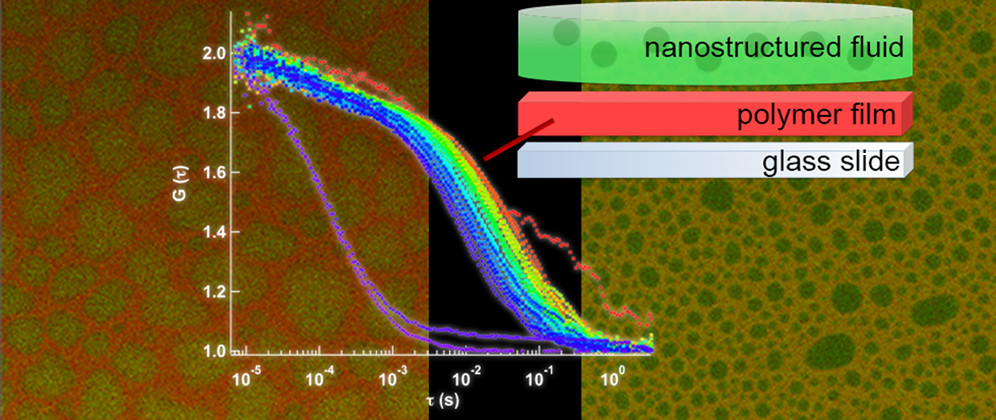We apply fluorescence correlation spectroscopy (FCS) to investigate molecular and macromolecular tracer diffusion in polymer (protein) solutions, cross-linked networks and melts. These studies are combined with confocal microscopy that provides additional information on the structure of the studied systems, e.g. phase separation in polymer blends or distribution of filers in composites. The unique, single molecule sensitivity of the FCS allows studies at nanomolar tracer concentrations, ensuring that the tracers do not modify the matrix polymer properties. Furthermore the very small observation volume (< 1fL) that FCS offers can be used to address systems with micron sizes, e.g. swollen anchored hydrogels, phase separated blends or biomolecular condensates.
For example, we employed FCS to monitor the translational diffusion of small fluorescent tracer molecules, dispersed at nanomolar concentrations in Polyisoprene (PI) films. We examined glass substrate supported films with thicknesses (d) spanning the range from 10 μm to 10 nm that correspond to d/Rg from 400 to 1, where Rg is the polymer radius of gyration. In thick films, a single diffusion process correlated to the bulk segmental dynamics of the matrix polymer was present. However, when the film thickness was smaller than the normal dimension of the FCS observation volume, a second, faster diffusion process appeared, reflecting enhanced segmental dynamics near the free surface. These results provide direct experimental evidence for the existence of a layer with enhanced mobility near the free surface of supported PI films at temperatures as high as 80 °C above the bulk Tg.

observed only in the presence of free surface in the FCS observation volume
In another example together with Debora Berti (University of Florence) we used FCS to study how surfactants mediate the dewetting of acrylic polymer films. In the past, such films were commonly applied to protect works of art. However, now they have to be removed to avoid even higher damage. Over the years, nanostructured fluids (NSFs), aqueous surfactant solutions containing a good solvent for the polymer, have been successfully applied in polymer removal interventions; however, the precise role of the surfactant in promoting polymer film dewetting is not fully understood. By combining confocal microscopy and fluorescence correlation spectroscopy, we monitored the penetration of the fluid into the polymer film, defining its compositional changes and following the polymer swelling. Our results showed that the surfactant role is twofold: (i) at the polymer–support interface, it promotes the detachment of the polymer film from the underlying support; (ii) inside the polymer film, it accelerates polymer swelling by increasing the chains’ mobility
.
Confocal microscopy images and FCS autocorrelation curves recorded at different positions and time intervals during the process
of dewetting of an acrylic polymer film
|

